Sydney central business district
| Sydney central business district Sydney, New South Wales | |||||||||||||||
|---|---|---|---|---|---|---|---|---|---|---|---|---|---|---|---|
 Sydney central business district | |||||||||||||||
 Sydney central business district | |||||||||||||||
| Coordinates | 33°52′5″S 151°12′44″E / 33.86806°S 151.21222°ECoordinates: 33°52′5″S 151°12′44″E / 33.86806°S 151.21222°E | ||||||||||||||
| Population | 17,252 (2016)[1] | ||||||||||||||
| • Density | 6,160/km2 (15,960/sq mi) | ||||||||||||||
| Postcode(s) | 2000 | ||||||||||||||
| Area | 2.8 km2 (1.1 sq mi) | ||||||||||||||
| LGA(s) | City of Sydney | ||||||||||||||
| State electorate(s) | Sydney | ||||||||||||||
| Federal Division(s) | Sydney | ||||||||||||||
| |||||||||||||||
The Sydney central business district (also Sydney CBD, and often referred to simply as "the Town" or "the City") is the main commercial centre of Sydney, the state capital of New South Wales and the most populous city in Australia. It extends southwards for about 3 km (2 mi) from Sydney Cove, the point of first European settlement in which the Sydney region was initially established. Due to its pivotal role in Australia's early history, it is one of the oldest established areas in the country.
Geographically, its north–south axis runs from Circular Quay in the north to Central railway station in the south. Its east–west axis runs from a chain of parkland that includes Hyde Park, The Domain, Royal Botanic Gardens and Farm Cove on Sydney Harbour in the east; to Darling Harbour and the Western Distributor in the west. At the 2016 Australian Census, the CBD recorded a population of 17,252.[1] "Sydney CBD" is very occasionally used to refer not only to the CBD proper, but also its nearby inner suburbs such as Pyrmont, Haymarket, Ultimo and Woolloomooloo.
The Sydney CBD is Australia's main financial and economic centre, as well as a leading hub of economic activity for the Asia-Pacific region. The city centre employs approximately 13% of the Sydney region's workforce. Based on industry mix and relative occupational wage levels it is estimated that economic activity ( GDP ) generated in the city in 2015/16 was approximately $118 billion.[2] Culturally, the city centre is Sydney's focal point for nightlife and entertainment. It is also home to some of the city's most significant buildings and structures.
Geography
The Sydney CBD is an area of very densely concentrated skyscrapers and other buildings, interspersed by several parks such as Hyde Park, The Domain, Royal Botanic Gardens and Wynyard Park. George Street is the Sydney CBD's main north–south thoroughfare. The streets run on a slightly warped grid pattern in the southern CBD, but in the older northern CBD the streets form several intersecting grids, reflecting their placement in relation to the prevailing breeze and orientation to Circular Quay in early settlement.
The CBD runs along two ridge lines below Macquarie Street and York Streets. Between these ridges is Pitt Street, running close to the course of the original Tank Stream (now tunnelled). Bridge Street, took its name from the bridge running east–west that once crossed this stream. Pitt Street is the retail heart of the city which includes the Pitt Street Mall and the Sydney Tower. Macquarie Street is a historic precinct that houses such buildings as the State Parliament House and the Supreme Court of New South Wales.
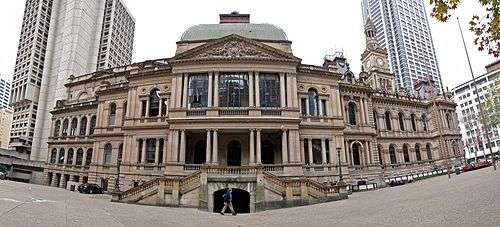
Heritage listings
Sydney CBD has many heritage-listed buildings including:
- 150-152 Elizabeth Street: Cyprus Hellene Club - Australian Hall[3]
Governance
Administratively, the Sydney CBD falls under the authority of the local government area of the City of Sydney.[4] The New South Wales state government also has authority over some aspects of the CBD, in particular through the Sydney Harbour Foreshore Authority. Independent Alex Greenwich has represented the Sydney seat since the 2012 by-election, triggered by the resignation of previous independent Clover Moore, who was the Lord Mayor of Sydney, due to introduced state laws preventing dual membership of state parliament and local council.
Commercial area
The Sydney CBD is home to some of the largest Australian companies, as well as serving as an Asia-Pacific headquarters for many large international companies. The financial services industry in particular occupies much of the available office space, with companies such as the Westpac, Commonwealth Bank of Australia, Citibank, Deutsche Bank, Macquarie Bank, AMP Limited, Insurance Australia Group, AON, Marsh, Allianz, HSBC, AXA, ABN Amro,[5], RBC and Bloomsbury Publishing all having offices.[6]
Church Hill
Church Hill is a northerly district in the Central Business district of Sydney, Australia.[7] It is so named because the earliest churches in Australia were formed on this site, including St Patrick's (Roman Catholic),[8] St Philip's (Anglican)[9] and Scots Church (Presbyterian)[10]
The significance of Church Hill dates back to the time of Governor Arthur Phillip, who mandated compulsory Sunday church attendance for all convicts, until they rebelled and burned down the area’s first church in 1798.[11]
The area gained greater prominence as Church Hill on Wednesday 1 October 1800, when incoming Governor Philip Gidley King had the foundation stone laid for St Philip’s Church, which subsequently he proclaimed one of Australia’s first two parishes in 1802 (the other being St John’s in Parramatta).[12]
The site where St Patrick’s Church currently stands is where the Roman Catholic Eucharist was first preserved in Australia, in May 1818. Celebrations for the bicentenary of this occasion were held in St Patrick’s Church on Sunday 6 May 2018.[13]
A proposed stop on the tram network under construction on George Street may be named Church Hill.
Transport
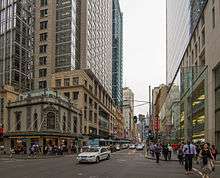
Sydney's CBD is serviced by commuter rail, light rail, buses and ferry transport. In addition, an underground rapid transit system known as the Sydney Metro is being developed: its first stage will link the central business district to the North Western suburbs of Sydney[14] and a second stage that will link the North Shore to Bankstown via a tunnel underneath Sydney Harbour and the CBD is proposed.[15][16]
Commuter rail's main hub is Central Railway Station ("Central"), located in the southern part of the CBD in Haymarket: it connects services for almost all of the lines in the Sydney Trains network, as well as being the terminus for NSW TrainLink country and inter-urban rail services. There is a largely-underground CBD rail loop, accessed in both directions via Central, which services five additional CBD stations, plus an underground spur line to Bondi Junction which services two. This is known as the City Circle. The Dulwich Hill Line, the only currently operating light rail line in Sydney (another is under construction) links the southern part of the CBD and Central to nearby suburbs of Sydney's Inner-west. Buses, both government-run and privately owned, service the CBD along several dozen routes to both inner and more remote suburbs. NightRide is an after-hours bus service that operates between midnight and 5:00 am, with most services running from George Street outside the Sydney Town Hall.[17] Sydney Ferries operate largely from Circular Quay, on the northern edge of the CBD. There are several wharves (directly beneath the elevated Circular Quay commuter rail station), with Wharf 3 operating exclusively to Manly. There are also ferries at the western edge of the CBD at King Street Wharf, just to the south of Barangaroo.
Culture
.jpg)
Sydney's culture is compacted within its central business district and inner city ring, due to its nightlife, pedestrian traffic and centrality of notable attractions. There is a large concentration of cultural institutions within the CBD including: the Museum of Sydney, the State Library of New South Wales, the Customs House branch of the City of Sydney Library, the Theatre Royal, the City Recital Hall and the Japan Foundation. There are a total of 19 churches located in the Sydney city centre.[18]
Many other cultural institutions are located at the surrounds of the CBD, such as: the Sydney Opera House and the Museum of Contemporary Art to the north, the Australian Museum and the Art Gallery of New South Wales to the east, the Powerhouse Museum to the west, White Rabbit Gallery and the Haymarket branch of the City of Sydney Library to the south.
Every January during the summer, the city celebrates with the Sydney Festival. There are art, music and dance exhibitions at indoor and outdoor venues. Australian and International theatre during the month is also featured, including Aboriginal, and Contemporary. Many of these events are free.
The Sydney Film Festival is an international event organised every year in June at various venues across the CBD. The festival opened on 11 June 1954 and was held over four days, with screenings at Sydney University. Attendance was at full capacity with 1,200 tickets sold at one guinea each.[19]
Sydney boasts a lively café culture, as well as a club and bar scene distributed throughout the CBD and concentrated in a couple of locations such as Darling Harbour.[20] Although Kings Cross is not technically located within the Sydney CBD, it is accessible via William Street, which runs through Hyde Park and is part of the inner-city region.
Architecture
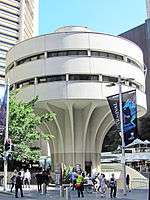
The Sydney CBD contains many of Australia's tallest skyscrapers, including Governor Phillip Tower, MLC Centre and World Tower, the latter consisting predominantly of apartments. It is also home to Australia's earliest skyscraper, the Australia Square building on George Street. As of 2017, the tallest structure is Centrepoint Tower at 309 m (1,014 ft) which has dominated the city skyline since it was topped out in 1981. Recently, height limits for buildings were lifted from 235 m (771 ft) to 310 m (1,017 ft).
Sydney's CBD features a juxtaposition of old and new architecture. The old architecture dates back to Sydney's earliest days as a colony, down to the more grandiose Victorian architecture from the Gold rush era–the most substantial examples are the Queen Victoria Building and the Sydney Town Hall. Modern architectures take form as high rises and skyscrapers, which are prolific among all of Sydney's city streets. The earliest skyscraper constructed in Sydney was Culwulla Chambers, which stands at a height of 50 m (164 ft) and was completed in 1912. Designed by Spain, Cosh and Minnett, the building consisted of 14 floors and cost £100,000 to build, equivalent of approximately $1 million in today's money.[21]
Demographics
- In the 2016 Census, there were 17,252 people residing in Sydney CBD. The median age was 30 years. Children aged 0 – 14 years made up 4.5% of the population and people aged 65 years and over made up 5.7% of the population.[1]
- 17.0% of the people were born in Australia. The most common countries of birth were Thailand (13.3%), China (excludes SARs and Taiwan) (11.7%), Indonesia (10.7%), South Korea (5.4%) and India (3.5%). Aboriginal and/or Torres Strait Islander people made up 0.2% of the population.[1]
- 25.3% of people only spoke English at home. Other languages spoken at home included Mandarin (14.6%), Thai (13.0%), Indonesian (9.1%), Korean (5.0%) and Cantonese (4.2%).[1]
- The most common ancestries in the CBD were Chinese (24.6%), Thai (11.3%), English (9.3%), Indonesian (5.1%) and Korean (4.9%).[1]
- The most common responses for religion in Sydney CBD were No Religion (31.7%), Buddhism (21.7%), Not stated (15.8%), Catholic (12.6%) and Anglican (3.3%).[1]
- 18.2% were couple families with children, 65.6% were couple families without children and 8.5% were one parent families. 33.4% were married.[1]
- 0.2% were separate houses, 0.0% were semi-detached, row or terrace houses, townhouses etc., 98.9% were flat or apartments and 0.6% were other dwellings. 15.7% of the homes were owned outright, 13.4% were owned with a mortgage and 65.7% were rented. 49.3% were family households, 31.8% were single person households and 18.9% were group households.[1]
Gallery


.jpg)
 Terraced buildings, now mostly demolished, looking towards the Royal Botanic Gardens and Bennelong Point, 1920s
Terraced buildings, now mostly demolished, looking towards the Royal Botanic Gardens and Bennelong Point, 1920s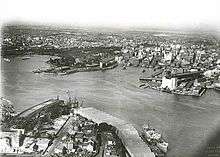 View towards Circular Quay, from the North Shore, c. 1930
View towards Circular Quay, from the North Shore, c. 1930- The central business district features heritage conservation for historic buildings, such as the former Burns Philp Building on Bridge Street.
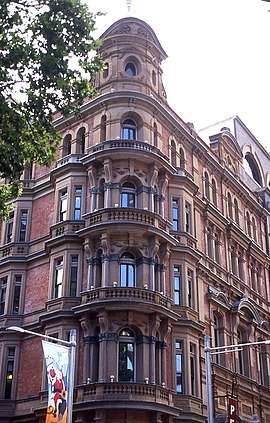 19th century York Street apartment building
19th century York Street apartment building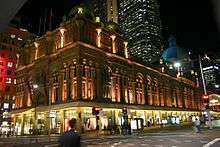 The QVB at night
The QVB at night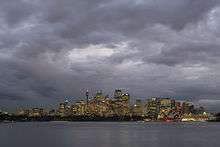 The CBD skyline illuminated at dusk from Cremorne Point
The CBD skyline illuminated at dusk from Cremorne Point Sydney city at sunrise. This photo is taken from Bondi Junction, New South Wales
Sydney city at sunrise. This photo is taken from Bondi Junction, New South Wales Western side of the CBD from Pyrmont
Western side of the CBD from Pyrmont
See also
References
- 1 2 3 4 5 6 7 8 9 Australian Bureau of Statistics (27 June 2017). "Sydney (State Suburb)". 2016 Census QuickStats. Retrieved 28 June 2017.

- ↑ "Australia's economic activity heavily concentrated in Sydney and Melbourne". taxpayer.com.au. 21 August 2014. Retrieved 31 March 2015.
- ↑ "Cyprus Hellene Club - Australian Hall (Place ID 105937)". Australian Heritage Database. Department of the Environment. Retrieved 13 October 2018.
- ↑ "Home". City of Sydney. Retrieved 6 April 2013.
- ↑ "Australia." ABN Amro. Retrieved 15 February 2017.
- ↑ "Contact Us." Bloomsbury Publishing. Retrieved 14 October 2012. "Bloomsbury Publishing Pty Ltd. Level 14 309 Kent St Sydney NSW 2000 Australia"
- ↑ "Church Hill". Retrieved 10 August 2018.
- ↑ "About St Patrick's Church Hill". Retrieved 10 August 2018.
- ↑ "St Philip's / Church Hill". Retrieved 10 August 2018.
- ↑ "Scots Church Sydney". Retrieved 10 August 2018.
- ↑ "Church Hill". Retrieved 10 August 2018.
- ↑ "Church Hill". Retrieved 10 August 2018.
- ↑ "200 years of the Blessed Sacrament celebrated at the "birthplace" of the Church in Australia". Retrieved 10 August 2018.
- ↑ "Funding secured: Sydney Metro to be a reality". Transport for NSW. 4 June 2015. Archived from the original on 23 June 2015. Retrieved 13 July 2015.
- ↑ Transport for NSW (2015). "Chatswood to Sydenham State Significant Infrastructure Application Report". 5.1 Overview and key components. p. 56. Retrieved 30 November 2015.
New metro stations at Crows Nest, Victoria Cross, Barangaroo, Martin Place and Pitt Street, as well as new underground platforms at Central Station
- ↑ Sarah, Gerathy (4 June 2015). "Power vote means Sydney Harbour rail crossing is less than a decade away: NSW Premier Mike Baird". ABC News. Retrieved 12 November 2015.
- ↑ NightRide bus tickets, Transport NSW Info. Retrieved 5 November 2014
- ↑ "Churches". sydneyorgan.com. Retrieved 22 June 2015.
- ↑ Kaufman, Tina (May 2003). "Looking Back, Looking Forward: the Sydney Film Festival at 50". Senses of Cinema. Senses of Cinema Inc. 26. Archived from the original on 15 April 2005. Retrieved 25 April 2005.
- ↑ "Sydney City". Destination New South Wales. Retrieved 6 April 2013.
- ↑ "Sydney's first skyscraper". State Library of New South Wales. Retrieved 11 January 2014.
External links
| Wikivoyage has a travel guide for Sydney – City Centre. |
![]()